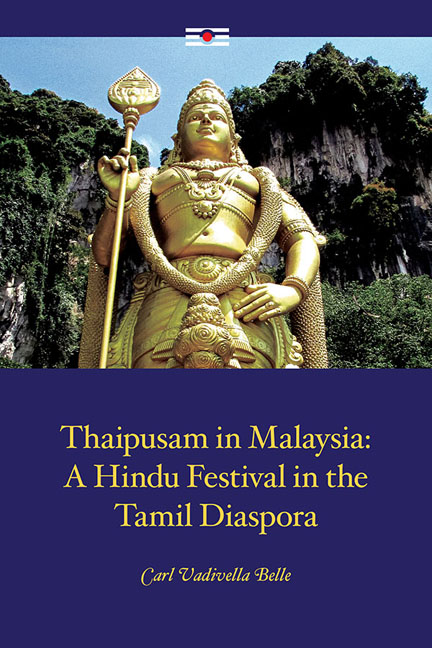Book contents
- Frontmatter
- Contents
- Acknowledgements
- Introduction
- 1 Indians in Malaysia: The Social and Ethnic Context
- 2 Tamil Traditions and South Indian Hinduism
- 3 Colonialism, Colonial Knowledge and Hindu Reform Movements
- 4 Hinduism in Malaysia: An Overview
- 5 Murugan: A Tamil Deity
- 6 The Phenomenology of Thaipusam at Batu Caves
- 7 Other Thaipusams
- 8 Thaipusam Considered: The Divine Crossing
- Conclusions
- Glossary
- Bibliography
- Index
- About the Author
4 - Hinduism in Malaysia: An Overview
Published online by Cambridge University Press: 12 January 2018
- Frontmatter
- Contents
- Acknowledgements
- Introduction
- 1 Indians in Malaysia: The Social and Ethnic Context
- 2 Tamil Traditions and South Indian Hinduism
- 3 Colonialism, Colonial Knowledge and Hindu Reform Movements
- 4 Hinduism in Malaysia: An Overview
- 5 Murugan: A Tamil Deity
- 6 The Phenomenology of Thaipusam at Batu Caves
- 7 Other Thaipusams
- 8 Thaipusam Considered: The Divine Crossing
- Conclusions
- Glossary
- Bibliography
- Index
- About the Author
Summary
The waves of Indian migration which followed the British colonization of Malaya and which continued up until the eve of the Pacific War were accompanied by the re-establishment of Hinduism as a significant minority religion in Malaya. The transplantation and historical evolution of Malaya/ Malaysian Hinduism has occurred in the absence of those traditional points of reference — namely, the religious centres of learning or monastic orders (mathas) which had provided a system of scriptural hermeneutics and exegesis, as well as an influential Brahman or dominant orthodox caste — which had such a marked impact upon Hindu structures, belief systems, mythology and patterns of worship in South India. The new arrivals in the estates and workplaces, lacking wider points of reference, tended to automatically reproduce remembered belief structures, practices and mores of the Hinduism of their home regions. Since the majority of Indian immigrants were either indentured or later kangany recruited labourers, the deities worshipped and the rituals associated with that worship largely revolved around the sub-communal norms of behaviour and caste variations of the village of origin. Over time these practices were in some cases reinforced, in others modified, in many more supplemented, by other regional and caste influences introduced to the estates, workplaces and cities of Malaya.
This chapter will provide a general overview of Hinduism as it has evolved in Malaysia. Professor Champakalakshmi has pointed out that religion cannot be isolated as an autonomous domain but must be considered in relation to the specific historical socio-political contexts in which it is implicated. Despite the enduring and formative influences of metropolitan Indian–Malaysian links, and those of more recent intradiaspora exchanges, and many profound resemblances to practices in the Indian “homeland”, Hinduism in Malaysia has followed its own unique trajectory, shaped by the specific historical and other circumstances which attended its importation and adaptation.
In seeking to explore Hinduism in Malaysia, I echo Vineeta Sinha's observation that it is necessary to move beyond fixed theoretical models of Hinduism, and in particular established hierarchical pantheonic Sanskritic/non-Sanskritic ranking, and to locate spheres of actual practice. Hindu belief and rituals in Malaysia are astonishingly heterogenous and involve a wide range of imported practices and traditions which have been subsequently moulded by a multitude of localized factors, including region, caste, ethnicity and class.
- Type
- Chapter
- Information
- Thaipusam in MalaysiaA Hindu Festival in the Tamil Diaspora, pp. 86 - 133Publisher: ISEAS–Yusof Ishak InstitutePrint publication year: 2017

